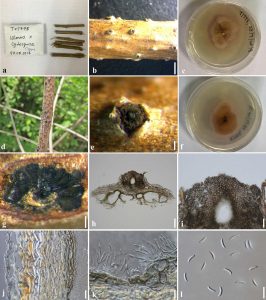Cytospora ulmicola Norphanphoun, Bulgakov, T.C. Wen & K.D. Hyde, sp. nov.; Index Fungorum number: IF555487
Etymology: The specific epithet ‘‘ulmicola’’ refers to the host plant genus Ulmus, on which the fungus was first collected.
Holotype: MFLU 17-2080
Associated with twigs and branches of Ulmus pumila L. (Ulmaceae). Sexual morph Undetermined. Asexual morph: Conidiostromata 1000–1700 × 500–800 μm diam., semi-immersed in host tissue, solitary, erumpent, scattered, discoid, circular to ovoid, with multi-loculate, pycnidial, embedded in stromatic tissue, with ostiole. Ostioles 200–500 μm long, with an ostiolar neck. Conidiomata walls comprising a few layers of pseudoparenchymatous cells of textura angularis, with inner layer thin, pale brown, outer layer brown to dark brown. Conidiophores unbranched or occasionally branched at the base, formed from the inner layer of the pycnidial wall. Conidiogenous cells (6–)9–14 × 1.3–1.8(–2.8) μm (x̅ = 11 × 2 μm, n = 15), blastic, enteroblastic, flask-shaped, phialidic, hyaline, and smooth-walled. Conidia (7–)8–9.5 × 1.5–1.7(–1.9) μm (x̅ = 8.5 × 1.6 μm, n = 30), unicellular, hyaline, oblong to allantoid, smooth-walled.
Culture characteristics: Conidia germinating on PDA within 12 h. Germ tubes produced from all sides. Colonies on PDA reaching 22–27 mm diam. after 2 weeks at room temperature, colonies irregular in shape, medium dense, flat to slightly raised, surface slightly rough, with small granular, to velvety, edge undulate with well-defined margin, from above pale orange to light brown at the margin, amber near the margin, with, zonate, pale yellowish to dandelion and dark amber at the centre; from below pale yellowish at the margin, with dark amber at the centre; not producing pigmentation in agar.
Material examined: RUSSIA, Rostov region, Shakhty City, street trees, on dead branch of Ulmus pumila L. (Ulmaceae), 27 May 2017, T.S. Bulgakov, T-1778 (MFLU 17-2080, holotype; PDD, isotype), ex-type living culture, MFLUCC 18-1227. GenBank numbers: ACT = MH940216, ITS = MH940220, LSU = MH940218, TUB2 = MH986792.
Notes: Cytospora ulmicola (MFLU 17-2080) was found on a dead branch (with signs of necrosis) of Ulmus pumila in European Russia. Cytospora ulmicola resembles Cytospora species in having an ostiolar neck with multi-loculate conidiostromata and unicellular, oblong to allantoid conidia. Phylogenetic analysis based on a combined ITS, LSU and ACT sequence dataset indicates that C. ulmicola clusters with C. cotini Norph. et al. (MFLUCC 14-1050), C. ampulliformis Norph. et al. (MFLUCC 16-0583), C. gelida Norph. et al. (MFLUCC 16-0634), and C. ceratosperma (Tode) G.C. Adams & Rossman (MFLUCC 16-0625). However, C. ulmicola can be distinguished from related species based on molecular data. A comparison of nucleotide polymorphisms of ITS and ACT shows that C. ulmicola differs from C. cotini with one polymorphism of ITS; from C. ampulliformis with one polymorphism of ITS and ten polymorphisms of ACT; from C. gelida with four polymorphisms of ITS and 13 polymorphisms of ACT; and from C. ceratosperma with five polymorphisms of ITS and eight polymorphisms of ACT. Therefore, following the guidelines of Jeewon and Hyde (2016) we introduce it as a new species.
Fig. Cytospora ulmicola (MFLU 17-2080, holotype). a Herbarium label and specimens. b, d, e Appearance of conidiostromata on branches of Ulmus pumila. c, f Colonies on PDA (c = from above, f = from below). g Transverse sections through conidiostroma to show an arrangement of the locules. h Longitudinal section through conidiostroma. i Ostiolar neck. j Conidiostroma wall. k Conidiogenous cells. l Conidia. Scale bars b = 1000 μm, e = 100 μm, g, h = 200 μm, i = 50 μm, j = 20 lm, k, l = 10 μm.

